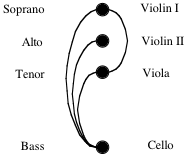Copyright © 2004 Society for Music Theory
2.2 Spacing Rule
[1] Although this essay is focused on doubling, we found it necessary to control for the effects of chord spacing. The reason is that the usual spacing rule makes some doublings more convenient than others.
[2] Theory textbooks commonly recommend that a chord have its largest space between its lowest voices. The psychological reason for this is well-established. The human auditory system has poorer resolution at low pitch levels; hence, if a chord is to sound transparent, extra space is necessary between low voices.(67)
[3] Following this rule will often lead a composer to double the bass.(68) If we assume that all upper voices are separated by less than an octave, then a chord with its largest space at the bottom will have three convenient ways to double the bass, but only one convenient way to avoid it (see Figure 2.2a).
Figure 2.2a. A schematic showing a possible well-spaced chord (made of dots) with a large space between the bass and tenor. The lines represent possible convenient ways to double a PC. Three involve the bass, but only one avoids it.
|
[4] This observation can be made more concrete by reference to our samples of triads from chorale harmonizations by Bach and string quartets by Haydn and Mozart. (See §4.1.) Among triads whose largest space is between the two lowest parts, 85% double the bass in the chorales, and 73% double the bass in the quartets. By contrast, when the largest space is not between the two lowest parts, only 57% double the bass in the chorales, and only 46% do so in the quartets.(69)
Copyright Statement
Copyright © 2004 by the Society for Music Theory. All rights reserved.
[1] Copyrights for individual items published in Music Theory Online (MTO) are held by their authors. Items appearing in MTO may be saved and stored in electronic or paper form, and may be shared among individuals for purposes of scholarly research or discussion, but may not be republished in any form, electronic or print, without prior, written permission from the author(s), and advance notification of the editors of MTO.
[2] Any redistributed form of items published in MTO must include the following information in a form appropriate to the medium in which the items are to appear:
This item appeared in Music Theory Online in [VOLUME #, ISSUE #] on [DAY/MONTH/YEAR]. It was authored by [FULL NAME, EMAIL ADDRESS], with whose written permission it is reprinted here.
[3] Libraries may archive issues of MTO in electronic or paper form for public access so long as each issue is stored in its entirety, and no access fee is charged. Exceptions to these requirements must be approved in writing by the editors of MTO, who will act in accordance with the decisions of the Society for Music Theory.
This document and all portions thereof are protected by U.S. and international copyright laws. Material contained herein may be copied and/or distributed for research purposes only.
Prepared by Brent Yorgason, Managing Editor and Tahirih Motazedian, Editorial Assistant


